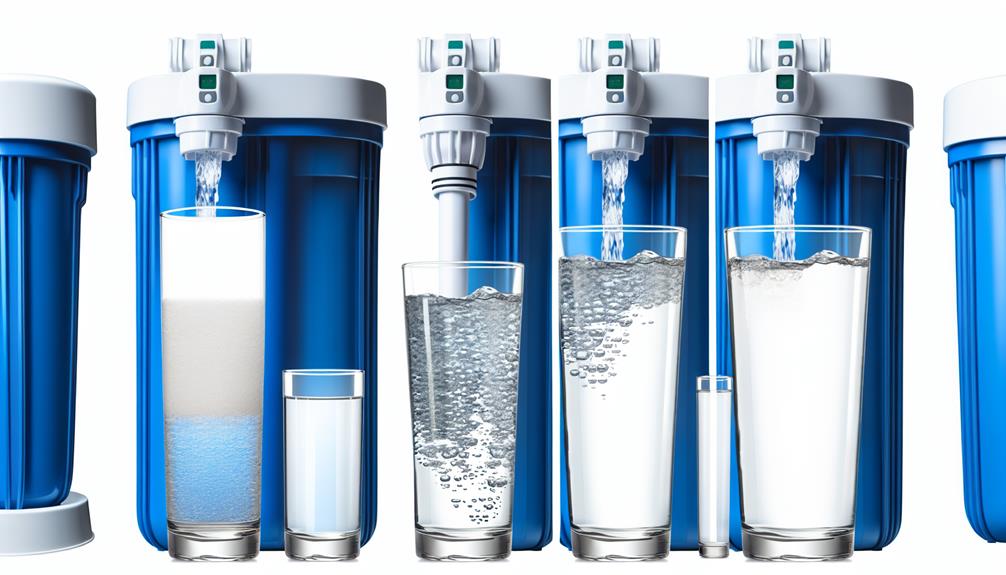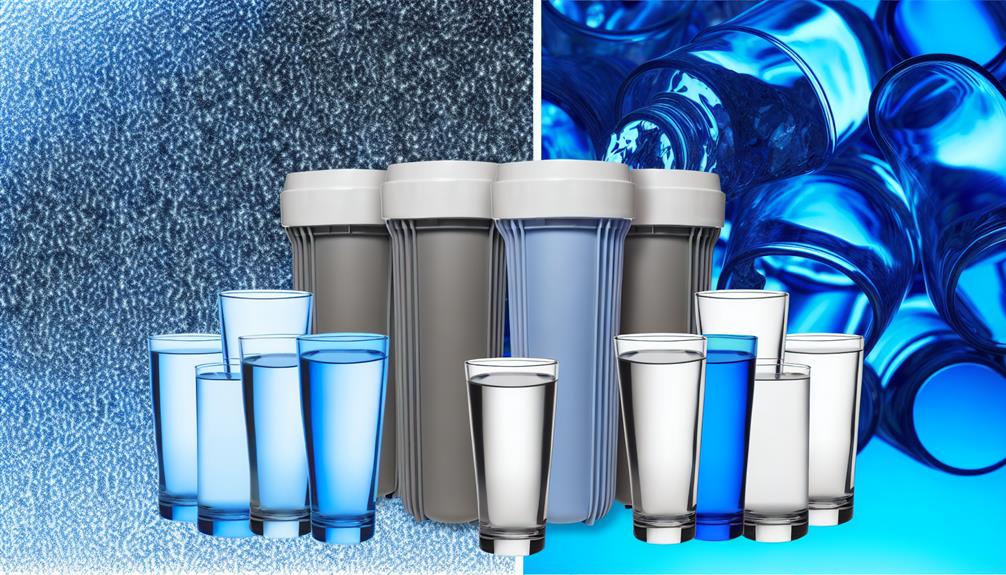When life gives you hard water, don't simply lament the limescale; instead, consider the myriad of water filters designed to tackle this pervasive issue.
You're well aware of the signs: the buildup on your faucets, the spots on your dishes, and perhaps even the impact on your skin and hair.
While hard water plagues many households, the right water filtration system can mitigate its effects, ensuring that your water is not only safe to drink but also kind to your appliances and plumbing.
From reverse osmosis systems that strip water to its purest form to salt-free conditioners that prevent minerals from depositing, the options are vast.
As you seek a solution tailored to your specific needs, you'll find that each system offers unique benefits and potential drawbacks.
The question remains: which one will best suit your home's requirements, and how can you make an informed decision without getting lost in a sea of technical jargon and marketing promises?
Stay tuned as we explore the top contenders, and you might just find the perfect match to turn your hard water woes into a forgotten tale.
Understanding Hard Water Challenges
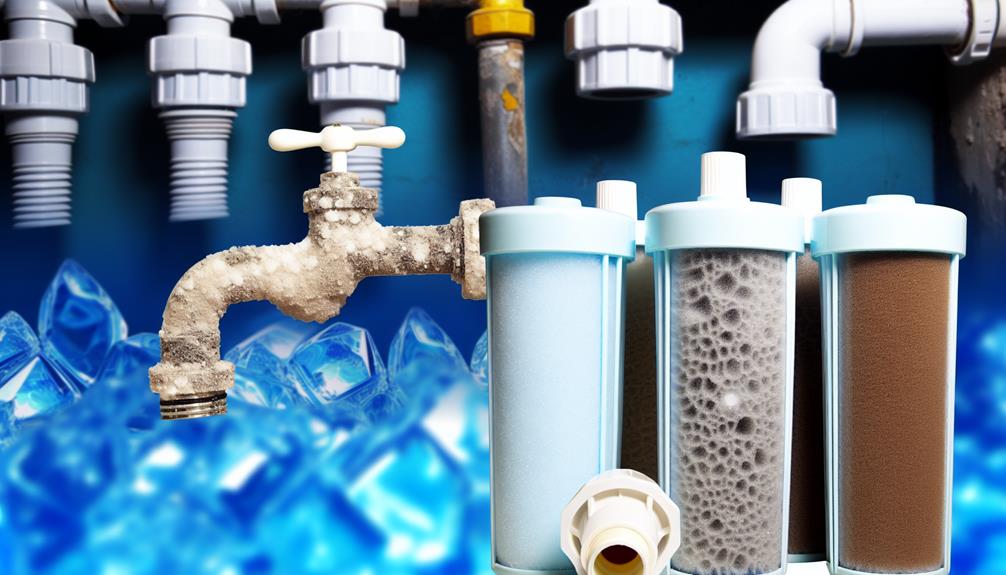
Dealing with hard water requires recognizing the mineral buildup that can clog your plumbing and appliances, reducing their efficiency and lifespan. You're likely contending with high concentrations of calcium and magnesium, which are the primary culprits behind the challenges you face.
These minerals, when dissolved, precipitate out as scale when water is heated, hindering the heat transfer in your water heater and forming insulating deposits that strain the system.
You'll notice water spotting on dishes, faucets, and glassware, a telltale sign that your water leaves behind mineral residues. These spots aren't just unsightly; they're indicative of the same scaling phenomenon that may be occurring inside your pipes and appliances. Over time, this can lead to significant maintenance issues and potential breakdowns.
Moreover, lathering difficulties while using soap or shampoo are another common symptom. Hard water inhibits the formation of suds, rendering cleaning agents less effective. This is due to the soap reacting with calcium and magnesium to form soap scum, a sticky substance that's difficult to rinse away. Consequently, you'll need to use more soap or detergent to achieve the desired cleaning effect, increasing your consumption and associated costs.
In essence, you're not just battling the visible effects of hard water; you're up against a pervasive issue that impacts your daily routines and household expenses.
Reverse Osmosis Systems
You'll find reverse osmosis systems are a sophisticated choice for tackling hard water in your home. They demand consistent maintenance to ensure peak performance, including regular filter replacements and system checks. Utilizing a multi-stage filtration process, reverse osmosis systems remove a vast array of contaminants. Understanding how reverse osmosis works is critical to appreciating its effectiveness and the technical precision required in its upkeep.
How Reverse Osmosis Works
Reverse osmosis systems effectively strip dissolved minerals and impurities from hard water by pushing it through a semi-permeable membrane under pressure. The reverse osmosis efficiency relies on advanced membrane technology that allows only water molecules to pass, while larger ions like calcium and magnesium are left behind.
- Pressure Application: High pressure forces water against the membrane, separating contaminants.
- Membrane Selectivity: Pores in the membrane are sized to exclude dissolved solids.
- Quality Filtration: Multi-stage filters may include sediment and carbon filters for pre and post-treatment.
- Waste Water: Some water is expelled as waste, carrying away the rejected impurities.
- Storage Tank: Purified water is stored, ready for consumption, emphasizing the system's efficiency and convenience.
Understanding these aspects ensures you're well-informed about the inner workings of reverse osmosis water filtration.
Maintenance of RO Systems
To ensure the longevity and optimal performance of your RO system, it's crucial to adhere to a regular maintenance schedule that includes filter replacement and system sanitization. Filter cleaning is an integral part of this routine.
Sediment pre-filters, which trap particulate matter, typically require replacement every 6-12 months. The carbon filters, responsible for removing chlorine and other contaminants, should also be replaced every 6-12 months.
The RO membrane itself has a longer lifespan, often 2-3 years, but this varies based on water quality and usage. Monitoring replacement intervals is analytical; it prevents the accumulation of contaminants and ensures efficient operation.
Remember to sanitize the system during filter changes to prevent bacterial growth, maintaining the purity of the processed water.
Salt-Based Water Softeners
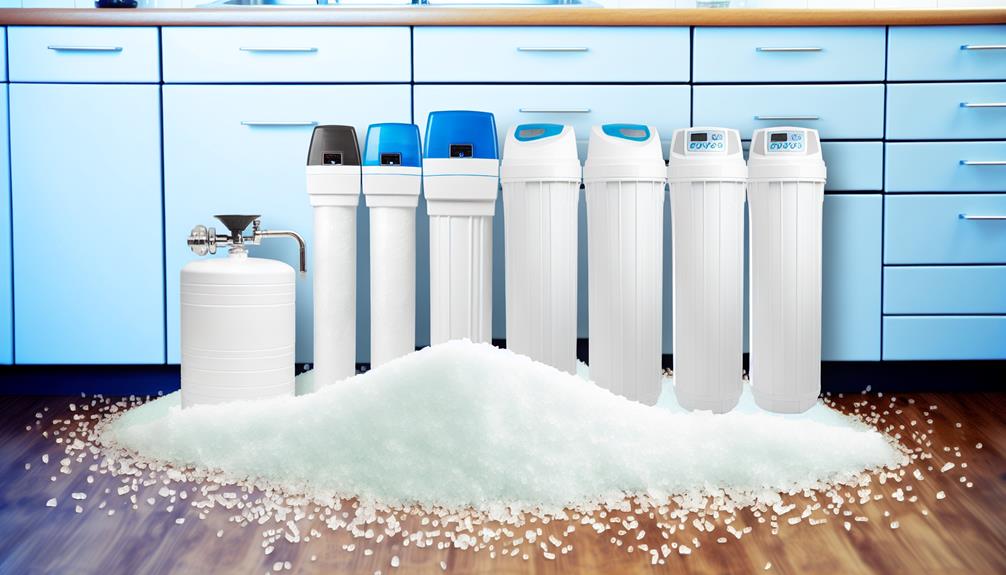
Salt-based water softeners are a prevalent choice among homeowners facing hard water issues. They utilize an ion exchange process to replace calcium and magnesium ions with sodium or potassium ions. This exchange is critical to softening water as it directly impacts water consumption and the effectiveness of your softener.
During the regeneration cycle, the system uses a brine solution to replenish the ion-exchange resin, ensuring it continues to function efficiently.
Here are key points to consider for a salt-based water softener:
- Capacity: Analyze the grain capacity to match your household's water usage.
- Regeneration Settings: Choose a unit with automatic settings to optimize the regeneration cycle based on actual water consumption.
- Type of Salt: Use the recommended type of salt—either sodium chloride or potassium chloride—for your specific device to maintain its efficacy.
- Efficiency: Look for models with high efficiency to reduce salt and water usage during regeneration.
- Certifications: Ensure the softener is certified by relevant authorities for performance and safety standards.
Salt-Free Water Conditioners
Unlike salt-based softeners, salt-free water conditioners function by crystallizing calcium and magnesium minerals, preventing them from adhering to surfaces and thus mitigating scale buildup without actually removing the hardness minerals from your water.
As you explore water softener alternatives, it's crucial to understand that while these systems don't provide TDS reduction, they play a significant role in protecting plumbing and appliances from the damaging effects of scale.
Salt-free conditioners operate through a process called Template Assisted Crystallization (TAC), which transforms the minerals into a crystalline form that doesn't stick to pipes and fixtures. This action is distinct from ion exchange in salt-based systems, where ions are swapped to physically remove calcium and magnesium. Here, the hard minerals remain in the water, but their modified structure reduces their ability to cause harm.
Analyzing the benefits, you'll find that these conditioners require less maintenance than their salt-requiring counterparts—they don't need regular salt refills or backwashing. This not only saves you time but also makes them an eco-friendlier option because they don't produce brine wastewater.
However, remember that if your goal is to lower TDS, you'll need to look at other filtration methods, as salt-free conditioners are designed specifically for scale prevention and not for purity enhancement.
Magnetic Water Descalers
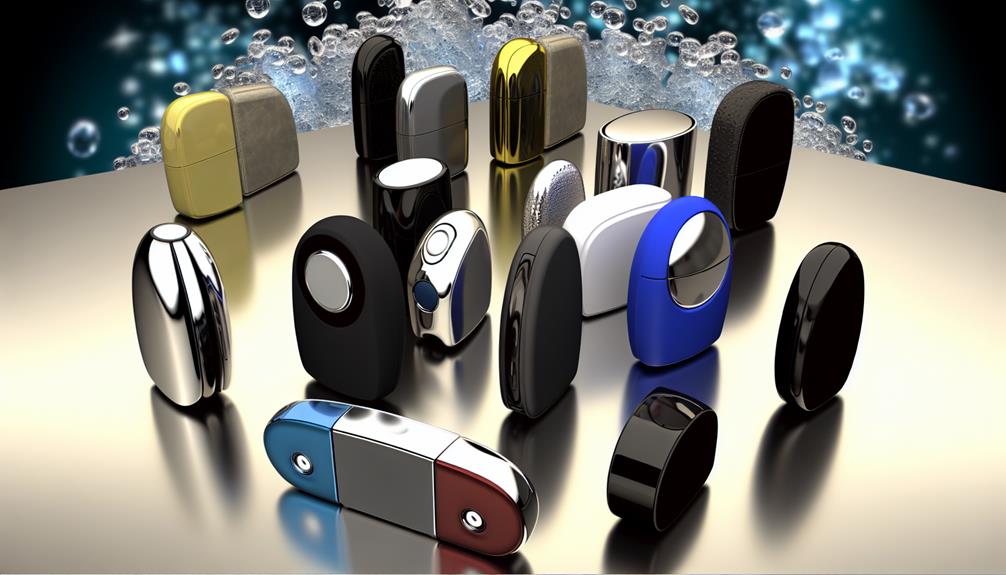
You'll find that magnetic water descalers offer an alternative method for addressing hard water issues by using magnetic fields to alter the electromagnetic properties of calcium carbonate minerals.
Understanding the principles behind their operation can help you assess their effectiveness for your specific water conditions.
When considering installation, precise placement and adherence to manufacturer guidelines are critical for optimal performance.
How Descalers Work
Magnetic water descalers operate by generating a magnetic field that alters the electromagnetic properties of calcium carbonate minerals, typically reducing their ability to form scale deposits in plumbing systems. This approach to scale prevention leverages water chemistry to address hard water issues without adding chemicals.
- Magnetic Field Generation: Creates a dynamic environment that impacts mineral structures.
- Calcium Carbonate Alteration: Changes the physical form to prevent scaling.
- Scale Prevention: Reduces the tendency of minerals to cling to pipes and appliances.
- Non-Invasive Method: Works externally, no need to cut pipes or disrupt water flow.
- Maintenance-Free: Once installed, descalers require no additional intervention or consumables.
Analyzing the efficacy of descalers demands a comprehensive understanding of magnetic fields and their interaction with water chemistry to prevent scale build-up effectively.
Descaler Installation Tips
When installing a magnetic water descaler, it's crucial to select a location on the main water line that's easily accessible for maintenance and inspection. You'll want to analyze the water line's material; certain metals may interfere with the magnetic field. Ensure water compatibility; the descaler works optimally with specific mineral concentrations.
Installation challenges often involve ensuring a tight fit without obstructing water flow. If the descaler is too loose, its effectiveness diminishes. It's essential to follow the manufacturer's guidelines for spacing and positioning to maximize the magnetic field's impact on the water's mineral structure.
Don't overlook the importance of securing the device firmly to prevent slippage, which could compromise its descaling function and the integrity of your water system.
Showerhead Filters for Hard Water
Showerhead filters specifically designed for hard water can significantly reduce the buildup of minerals and impurities that often lead to clogged nozzles and skin irritation. By addressing the mineral overload, these filters not only help maintain your shower's performance but also contribute positively to your hair health and skin condition by filtering out harsh elements.
When considering showerhead filters, focus on the following features for maximum efficacy:
- Filtering Capability: Select a filter with proven effectiveness against calcium, magnesium, and other hard water minerals.
- Maintenance: Look for filters that are easy to clean or replace to ensure they remain effective.
- Compatibility: Ensure the filter fits your existing shower setup to avoid unnecessary modifications.
- Durability: Opt for filters made from robust materials that can withstand the rigors of daily use.
- Health Benefits: Consider filters that add skin and hair-nourishing elements like Vitamin C or other neutralizing agents.
Analyzing these aspects ensures you invest in a showerhead filter that not only battles the effects of hard water but also upholds the health of your skin and hair.
Whole House Filtration Units
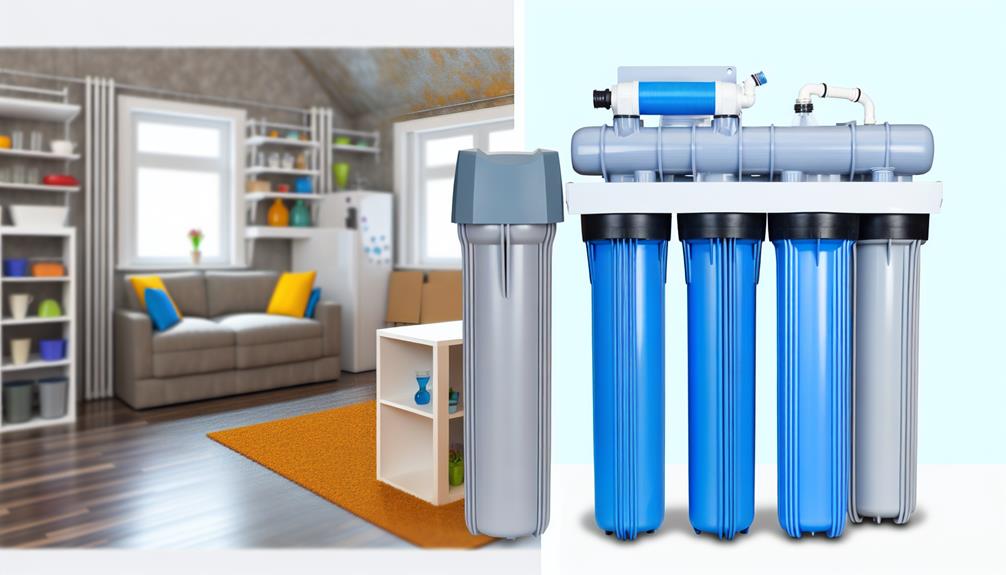
As you consider whole house filtration units, it's crucial to understand the various types available and how they tackle hard water minerals.
You'll need to evaluate installation requirements, including space and compatibility with existing plumbing systems.
Additionally, be mindful of the maintenance demands and the expected lifespan of the units to ensure cost-effectiveness and consistent water quality.
Types of Whole Filters
To effectively combat the challenges of hard water, several types of whole house filtration units are available, each designed to remove specific contaminants and minerals that contribute to water hardness. The choice of filter media is crucial, as it determines the unit's efficacy in targeting the hard minerals like calcium and magnesium. Moreover, you'll need to consider the frequency of cartridge replacement, which can vary depending on the type and concentration of minerals present in your water supply.
- Sediment Filters: Capture larger particles such as sand and rust.
- Activated Carbon Filters: Absorb organic compounds and chlorine.
- Ion Exchange Units: Soften water by exchanging calcium and magnesium ions with sodium or potassium ions.
- Reverse Osmosis Systems: Remove a broad range of contaminants through a semi-permeable membrane.
- Magnetic or Electronic Water Conditioners: Alter the electromagnetic properties of calcium and magnesium, preventing scale buildup.
Installation Considerations
When installing a whole house filtration unit, you must consider both the compatibility with your existing plumbing system and the spatial requirements for the equipment.
Pipe compatibility is crucial; you'll need to ensure that the unit's connections match your home's pipe size and material—whether it's copper, PVC, or PEX. An adaptor may be necessary if discrepancies exist.
Space requirements are equally important. The unit should be positioned where it can be easily accessed for maintenance, without obstructing other utilities or storage areas. You'll have to measure the designated installation area to guarantee the system fits, leaving adequate clearance for filter changes.
Analyze your utility room's layout to optimize the placement of the filtration system, maintaining a balance between accessibility and compactness.
Maintenance and Lifespan
Maintaining your whole house water filtration system is essential to ensure its longevity and optimal performance. Regular maintenance involves a detailed cost analysis to budget for periodic filter replacement and other potential expenses. Here's what you need to keep in mind:
- Pre-filter changes: Typically required every 2-3 months, depending on water quality.
- Media replacement: Key for systems using specific media to tackle hard water minerals.
- System flushes: Vital to prevent sediment and mineral buildup within the unit.
- Seal and O-ring inspections: Crucial to avoid leaks and maintain system pressure.
- Professional assessment: Recommended annually to ensure the system's integrity and efficiency.
Under-Sink Water Filters
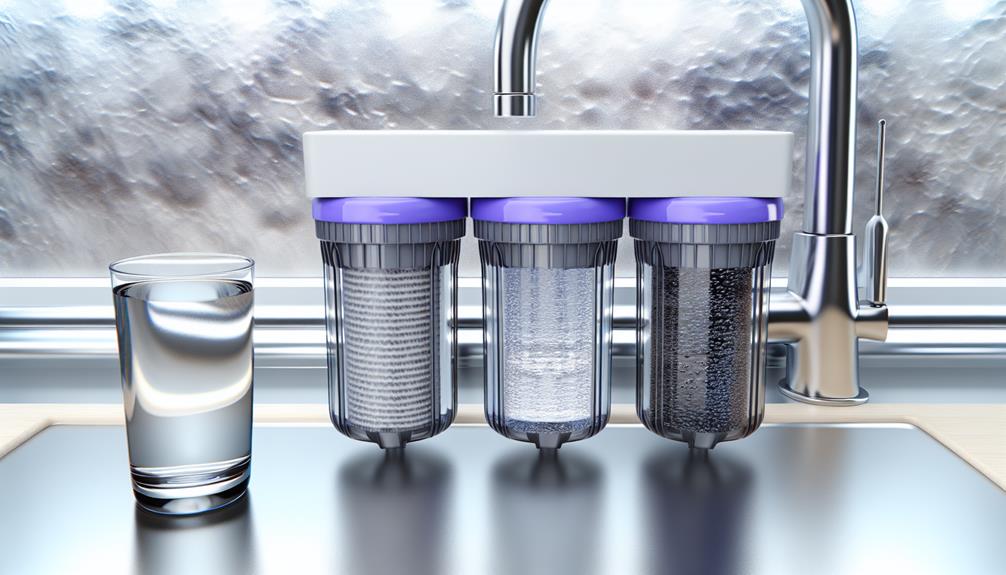
Under-sink water filters offer an effective solution for homeowners seeking to combat the issues associated with hard water directly at the tap. The strategic filter placement beneath the sink ensures that water is treated just before it exits the faucet, allowing for immediate contaminant removal. This point-of-use system targets a variety of impurities, including calcium and magnesium—the culprits behind hard water.
When selecting an under-sink filter, it's crucial to analyze the specifications regarding its capacity to mitigate hardness minerals. Pay attention to the filter media used; some might employ ion-exchange resins which are specifically designed to exchange hard ions with softer ones, thus softening the water. It's also important to consider the micron rating of the filter, as this determines the size of the particles that can be filtered out.
Moreover, you'll want to examine the flow rate, ensuring it matches your household demands without compromising water pressure. The maintenance requirements are equally important; some systems feature easy-to-replace cartridges that don't necessitate professional service.
Portable Water Softening Solutions
Portable water softeners present a versatile and mobile solution for addressing hard water issues, particularly for those who frequently travel or require a temporary fix in varying locations. When considering a portable water softener, you're likely looking for a product that not only effectively reduces water hardness but also offers convenience and ease of use.
To ensure you make an informed decision, focus on the following technical aspects:
- Cartridge Longevity: Evaluate the lifespan of replacement cartridges, as frequent changes can be costly and inconvenient, especially when on the move.
- Regeneration Cycle: Understand the regeneration process—some units allow for manual regeneration, providing control over the timing and frequency.
- Capacity: Assess the grain capacity, which determines how much hardness the softener can remove before requiring regeneration.
- Travel Adaptability: Look for features that enhance portability, such as compact design, lightweight construction, and ease of installation and disassembly.
- Water Flow Rate: Analyze the flow rate to ensure it meets your water usage needs without significant pressure drops, which can be a concern in portable models.
Pitcher Water Filters
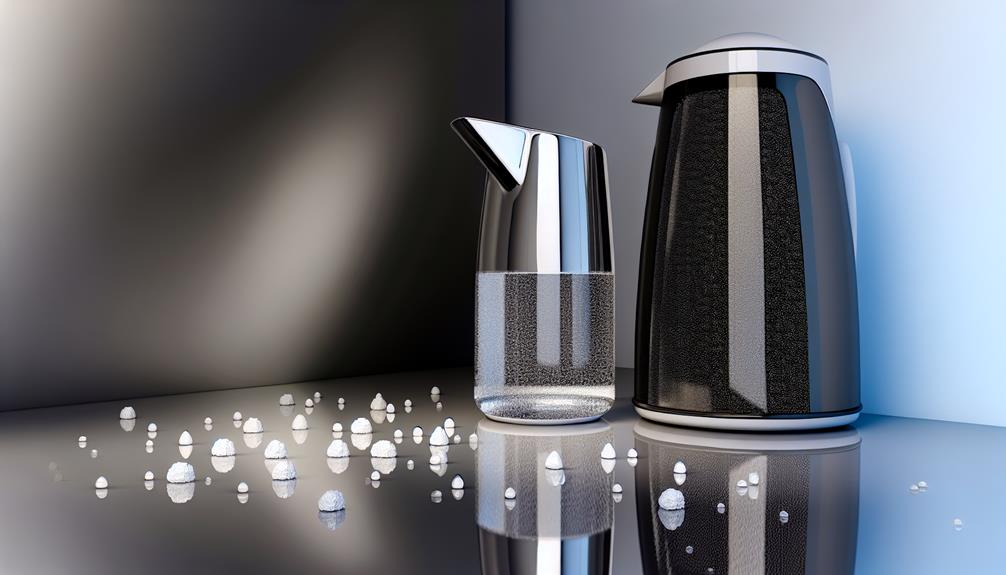
While portable water softeners offer mobility for tackling hard water, pitcher water filters provide a user-friendly and space-saving option for improving water taste and quality in your home. These filters typically feature a multi-stage filtration process, which may include ion-exchange resins specifically designed to reduce the minerals responsible for water hardness.
You'll find that the filter lifespan of these pitchers is a critical factor to consider. Typically measured in gallons filtered or time used, the lifespan indicates how often you'll need to invest in cartridge replacement. It's important to note that the presence of hard water may reduce the filter's lifespan due to the higher concentration of minerals that must be processed.
When examining pitcher filters, pay close attention to manufacturer specifications regarding the filter's capacity to handle hard water. Regular cartridge replacement is essential to maintain optimal performance, as a saturated filter loses its effectiveness over time. Advanced models might offer electronic indicators that alert you when a cartridge replacement is due, enhancing convenience and ensuring continuous access to softened water.
In your analysis, don't overlook the cost of replacement cartridges in relation to the filter's lifespan. This insight will guide you in selecting a pitcher water filter that balances efficiency, maintenance frequency, and ongoing expenses.
Faucet-Mounted Filtering Devices
Faucet-mounted filtering devices offer a convenient and direct method for purifying tap water. They attach directly to your kitchen faucet and typically incorporate a combination of carbon filters and ion-exchange resins to reduce water hardness and remove contaminants.
When you're analyzing options, you want to consider not just effectiveness, but also how the system will integrate with your faucet aesthetics and the expected improvement in filtered water taste.
Here are key considerations to bear in mind:
- Compatibility: Ensure the filter fits your specific faucet model and design.
- Filter Lifespan: Check how often you'll need to replace the filter based on your water usage.
- Contaminant Reduction: Look for certifications that guarantee the removal of specific contaminants and hardness minerals.
- Flow Rate: Analyze how the device impacts your water flow, as some filters may reduce the rate at which water is dispensed.
- Aesthetics: Choose a design that complements your kitchen's decor and doesn't obstruct functionality.
These devices typically offer a straightforward installation process, and many models feature an indicator for filter replacement, which aids in maintaining the quality of your water.
Conclusion
You've explored the top solutions for hard water, from reverse osmosis to portable softeners. Each system has its merits, tailored to different needs and scales of use.
Evaluate your space, water usage, and installation preferences to select the optimal filter. Remember, efficiency and longevity hinge on regular maintenance and understanding the technical specs.
Choose wisely to ensure your water isn't only softer but also conducive to a healthier, scale-free home environment.
